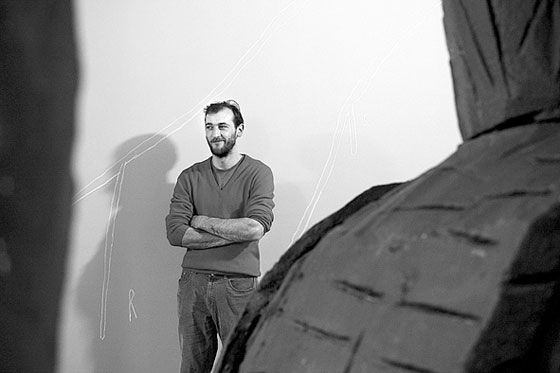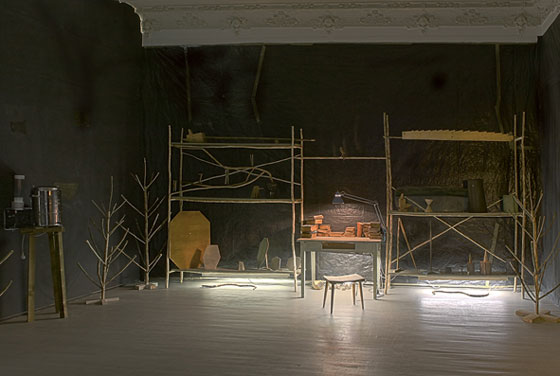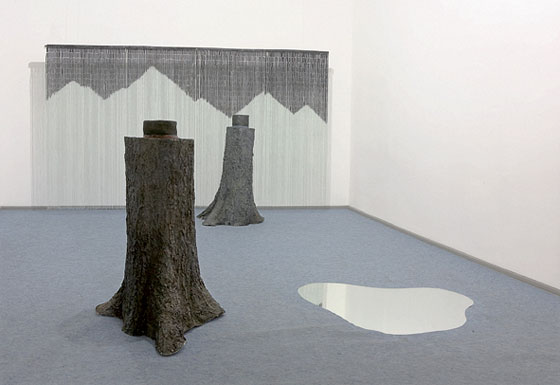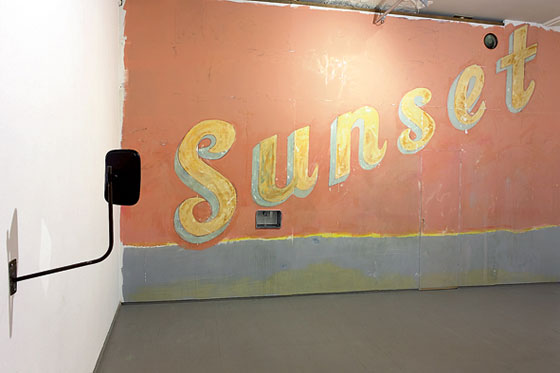|
|
| Temporal dimensions Eglė Juocevičiūtė, Art Critic, Curator Žilvinas Landzbergas. The Future is Now 15.11.2011.–07.01.2012. Vartai Gallery, Vilnius For Ever Again 04.11.–11.12.2011. kim? Contemporary Art Centre, Riga | |
| You are enticed to enter the chimneyless little smokehouse by the model workshop of a gifted builder and master of religious sculpture (Lith. dievdirbys). On the shelves there are half-complete and finished little sculptures, on the black wall there are drawings of sculptures done in white chalk. But the most important thing of all, squeezed in between the shelves, is a table piled high with books. Above it, on a whittled, bent stick, sits a little bird. It’s all illuminated from far down underground, from the place where the snakes slither. For a couple of months the Vartai Gallery in Vilnius became a memorial museum, or at least half of it certainly did. The installation Sunset (2011) by Žilvinas Landzbergas consisted of two parts. The first was the sunset area with a rusted fountain and drinks vending machine next to a wall adorned with a faded fresco. On going behind the fresco, we entered the workshop of a master of religious sculpture. It could actually have been the workshop of Landzbergas himself, had he travelled by time machine to Vartai from the first half of the 20th century. Or, if Landzbergas had travelled at least 90 years into the past and, having lost hope of returning to us, had set himself up in one of the sandy villages of southern Lithuania, and had proceeded to carve books, letters, snakes, hats and dogs’ heads from blocks of wood. He’d have become known as the local eccentric, and through his personal charisma and convincing talk would gradually have grown into a local legend. And if through some historical injustice his humble workshop had been wrecked and forgotten, then right now, in this time of archives and microlegends, it would have been reborn in all its splendour. | |
 Žilvinas Landzbergas. 2011 Photo: Ansis Starks | |
| Almost at the same time when this ‘found’ workshop of Landzbergas was being displayed in Vilnius, ‘relics’ by Landzbergas from another ‘discovered’ workshop that had unfortunately burned down were being exhibited in Riga, at the kim? Contemporary Art Centre. Evidently, he had established this workshop after the same time machine had brought him to the land of giants. The immense timber sculptures in the wooden workshop were readily consumed by a hungry flame that had come from heaven knows where. In the charred remains of the workshop it was hard to distinguish sculptures from branches prepared for carving. But Landzbergas’ fans eagerly await and evaluate each newly-found piece of wood that he has fostered. Thus, at kim? we saw an immense, soot-blackened wooden head and several massive, blackened branches, reminiscent of the letters S, F and C. On the walls were authentic sketches by Landzbergas, revealing the artist’s chain of thought. Art historian Ūla Tornau has distinguished three separate temporal frames in the installations of Landzbergas. The first is the present, the time when the viewer is present in the installation, the short period when you cross the threshold into the gallery and cannot yet comprehend what’s going on. And the moment when you leave the installation and move on through the exhibition. The second temporal frame is the time of the ‘found’ narrative, the ‘before’, ‘after’ and ‘why’ that you put together in your head in striving to understand. It’s most convenient to create a mythical world of folktales, such as the one I delved into when writing these lines: without logical limitations of time or space. More precisely, it functions according to the logic of dreams, which we successfully apply in our subconscious, and which requires no plot. However, having entered the installation of Landzbergas with conscious intent, we do seek a plot. The only way to create a narrative that fits into the framework of contemporary artistic rhetoric is to arrange the objects of the installation in your imagination one by one and ‘unwrap’ them, determining what they are dedicated to. This is how the third temporal frame distinguished by Tornau comes about: the apparent time of objects constituting the particular installation. In Landzbergas’ installations it most commonly shifts between the modernist time of industrial mass production (which in essence is much the same in socialism as in capitalism) and the 1990s in post-Sovietism. That which in the late autumn “stretched” between Vilnius and Riga became in the early summer The Future is Now, a part of the project Curated by_Viena 2011: EAST by SOUTH WEST, shown at the Projectraum Victor Bucher in Vienna. Stretched out geographically, the exhibition was split into three separate installations and augmented with new objects, contexts and aspects. Sunset was demonstrated in Vilnius, along with an installation which had inherited the name of the exhibition The Future is Now, while For Ever Again was shown in Riga. Four different spaces were created in the three installations. They might be termed the public space, the closed space, the mythical forest space and the mythical space around a fire. The first two formed part of the Sunset installation. On entering the Vartai Gallery, you immediately found yourself in a small area – the public space, where you were enticed by liquids (a fountain and drinks vending machine) and was which decorated with a faded fresco à la 1960s or Ed Ruscha featuring the word “Sunset”. After a drink was poured from the vending machine installed in the fresco, further progress was halted by a mirror attached to the wall. Once you saw yourself with a glass of drink and “Sunset” in the background, you too became a participant of the story. | |
 Žilvinas Landzbergas. Sunset. Installation. Fragment. 2011 Photo: Arturas Valiauga | |
| The objects in the installation included a fountain leaping about in a rusted tub, plastic glasses floating in the water around it and a vending machine that poured a drink of unknown origin. I can believe that the attempts to create an attractive public space by offering automatic attractions and services succeeded admirably both in the socialist and the capitalist city, so long as there was the desire and the money to maintain the vending machines. However, in the socialist cities, and maybe in the capitalist cities as well, the desire and the money lasted only a short while. And so the untended attractions became symbols of a non-functional and unattractive public space. The almost neo-symbolist “Sunset” fresco marked the boundary between the non-functioning public space and the mythical space, which we reached through a door in the fresco and which we’ve named the workshop of the master of religious sculpture. Here, in this workshop established at some unknown time, you could feel safe from all the problems of the world. Even though it might seem that a workshop should serve a clear and practical aim, the signs of production and physical labour had been removed. Here you could see and contemplate books (blocks of wood with veneer covers) and outlines figures drawn on the wall. And by the hand of providence, magic or marvel, the shelves were covered with of figurines. It was the kind of mythical intellectual space where Plato, Thomas Aquinas or Joseph Beuys might have worked, but where Žilvinas Landzbergas had now established himself. In the exhibition in Vienna the thinker’s little table and books stood in a white, brightly lit room, as if referring to the image of the Austrian School of philosophy, which is an “old-fashioned” but at the same time urban and long-lasting tradition. If we compare the Vienna and Vilnius versions of the exhibition, we can also discover a Lithuanian version of the rural thinker. As we proceed further into the gallery, we enter another of Landzbergas’ installations: The Future is Now, in the mythical forest space. Sunset and The Future is Now have an interesting relationship when placed side by side, if we imagine that next to the sunset space there stands a multi-storey apartment block with room for the workshop of a master of religious sculpture, and for a flat from the 80s with a surrealist interior. The installation The Future is Now consisted of a sky-blue rug, a puddle of mirror glass, two tree-stumps, bamboo slat blinds and two salt lamps in the form of lumps of lava. The exhibition remained open until January, which meant that on Christmas Eve (the winter solstice) a group from the House of Teachers could take the two stumps, albeit made of rubber, and drag them down a street in Vilnius and through all the courtyards. This vision entered my mind when I remembered the pagan tree-stump, symbolising roots (the beginning and the end), and the dragon and all the evils that must be vanquished to ensure the Sun’s return. And so, having dragged tree-stump through the whole village, the Balts burned it. | |
 Žilvinas Landzbergas. The Future is Now. Installation. Fragment. 2011 Photo: Arturas Valiauga | |
| Being more complex than the ethnographic tree-stump, the tree-stumps of Landzbergas are not threatened with this fate. Placed on them was something resembling a broad-brimmed hat or top hat. In my table of symbols it acts in two directions: as a receptacle into which magicians place rabbits and doves, and as an attribute of the representative of the old system and the opponent of equality in George Orwell’s ‘1984’. To destroy or at least conceal the roots and the dragon of past evil (the system): perhaps this is why there was a top hat on the stump? The puddle, in accordance with the logic of the tree-stump, is the eye of chthonic evil, in this case reflecting the ceiling of the gallery, covered in netting, and our own surprised faces. Once again, you unwittingly became part of the installation: chthonic evil is not so easily visible. It cannot be seen also because the ‘underworld’ is covered by a sky-blue, clean rug, so it turns out that everything is upside down. In Vienna the blind of wooden slats with its mountain landscape hung in the centre of the room, serving as a penetrable, see-through wall between the two parts of the installation. In the Vartai Gallery it hung on the wall like a poster or wall rug, embodying the dream of “seeing the mountains”. The “mountains”, just like the shiny pieces of salt, extended the geography of the installation, so that we could take an international view of this landscape confined within a square room. In this way, the Lithuanian tree-stump can become, for example, the tree-stumps of the Black Forest and of the operas of Richard Wagner. In the context of the exhibition The Future is Now in Vilnius and For Ever Again in Riga, the wall in the Vartai Gallery where the blind was hung became a portal to Riga or even marked the border between Lithuania and Latvia, which is very easy to cross physically, whereas mentally you have to cross “mountains”, because those on the other side are different. When it was physically and mentally relocated to Riga, the installation Forever Again included a fourth space: the space around a fire. Interestingly, the space around a fire – the oldest, archetypical place for people to engage in fortune-telling – has also found a place in the theory of British architecture critic Rayner Banham on the contrasting character possessed by bounded space and power-operated space (‘The Architecture of the Well-tempered Environment’, 1969). After all, a bounded space exists because there are boundaries – it is enclosed by the walls, ceiling and floor – and is perceived more as a place than a space. This is the kind of space re-presented by the very first shelter that people created. It has a very clear boundary between inside and outside, between the tamed and the wild. The other we distinguish with our senses: by the heat, aroma, sound, light or colour. An example of this could be the warm and light space surrounding a fire, the wholeness of which we can sense as long as the waves of heat and light energy are flowing. Banham maintains that evaluation of the first kind of space requires quantitative criteria, such as size and ceiling height, while the second kind requires qualitative criteria, namely how a person feels in the space. | |
 Žilvinas Landzbergas. Sunset. Installation. Fragment. 2011 Photo: Arturas Valiauga | |
| In Landzbergas’ installation the impression of a fire is created by a shining rich red band of light at the base of one wall, an imitation of a flame in the form of a material set in motion by the wind from a fan, and charcoal black objects made of foam. Thus, it is an artificial fire, whose “fireness” is only visual, without any energy (heat) field to indicate to the senses the limits within which this space is active. In spite of this, the visual impression of the ‘fire’ is convincing and turns a place into a space. In my view, this happens for two reasons. In the first place, there is no separable inside and outside. You feel this at the close of the journey through the exhibition, when you contemplate the miniature installation created in the wall behind the huge objects: a small room resembling a gallery. It is an object entitled It’s later than you think, which has already featured in several of Landzbergas’ installations. When you look inside through a hole cut out of the wall, you end up outside, because you’re looking in. The “fire” along the wall and the “charred” sculptures, although quite evidently artificially, do act as an illusion and, if only briefly, really do take you outside of the main gallery kim?. At the same time, the drawings on the wall return you to the inside, to a closed, scientifically creative space. Thus – examining it from the beginning this time – we enter a bounded space that is delimited, according to Banham’s theory. However, here we find an illusion of a space created by energy, a power-operated space, and at least until we comprehend that it’s an illusion, in our thoughts we are transported somewhere far away. We are brought back to the gallery by the drawings on the wall, and the small gallery created in the wall makes us take look at our presence in the gallery from the outside. A second factor that influences the spatial quality of Forever Again relates to the way in which Banham defines the changing relationship between place and space in 20th century architecture. In addition to other, more technical aspects (lighting, heating and air conditioning), he emphasises that architects started to assess projects by considering the fourth dimension – that of time, or more precisely, experience. Place and space, boundaries and energy merged into a hybrid totality. And so let us return to the time dimension of Landzbergas’ installation. Forever Again does not contain the kind of socio-cultural pointers to a particular period in history that we see in Sunset. Rather, it is a more profound study of what happens in the workshop of a Vilnius master of religious sculpture. In this way a kind of closed circle of creative activity is formed, where the cause and effect exchange places: the small space in the wall, even if it is seen as a pointer to the gallery as a social phenomenon, may also be regarded as representing the artist’s consciousness, which is at present fairly empty, but where several spaces have developed, in which objects are, in their turn, coming into being. The period of searching for form is characterised by the drawings on the wall, and the objects, squeezed with difficulty into the gallery, indicate the immense, grand-scale labour that the artist undertakes in creating his art. The objects testify to cultural forms created by someone else (Pinocchio) and repeat natural forms, which become the forms of language (wooden letters). Finally, when it all burns or chars, an immense charcoal log draws a fresh line on a white wall. These phases may move in any sequence, and each phase, having ended up at a different time in our imagination, can create a slightly different kind of energy. Time, the most important key for unlocking the meanings of Žilvinas Landzbergas’ installations, in this case has become a very important actor in the installations, if we imagine an ideal viewer who has decided to view both exhibitions on the one occasion. The four-hour journey between Riga and Vilnius could have become – and in fact maybe did for somebody – a journey during which the objects seen in the galleries found their places in the autumnal Baltic forests and fields. /Translator into English: Valdis Bērziņš/ | |
| go back | |







